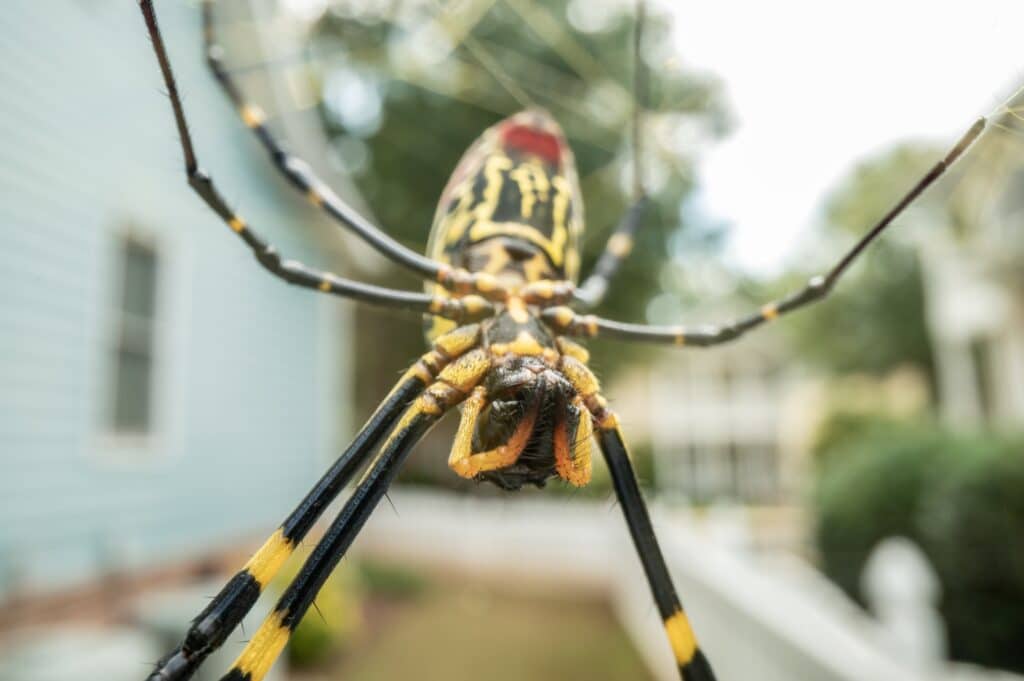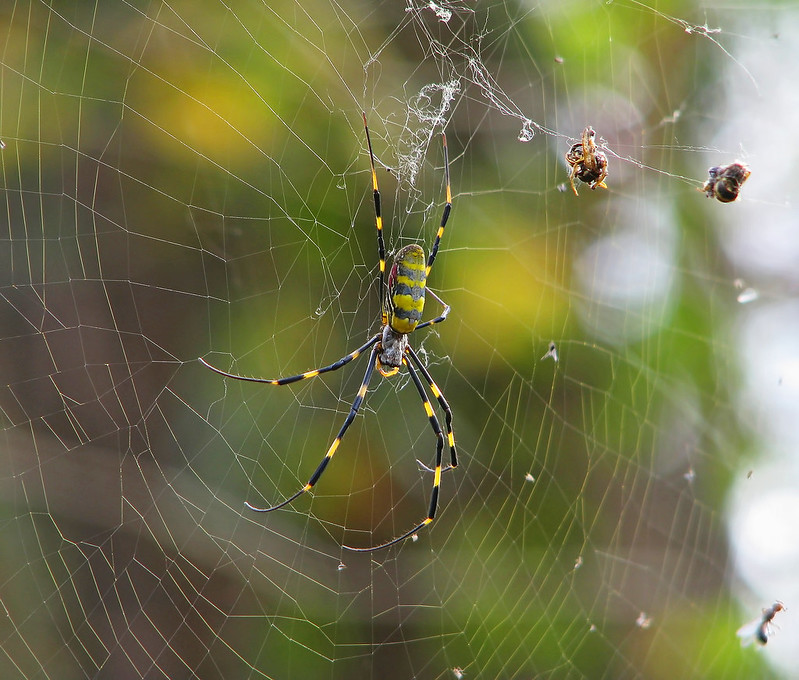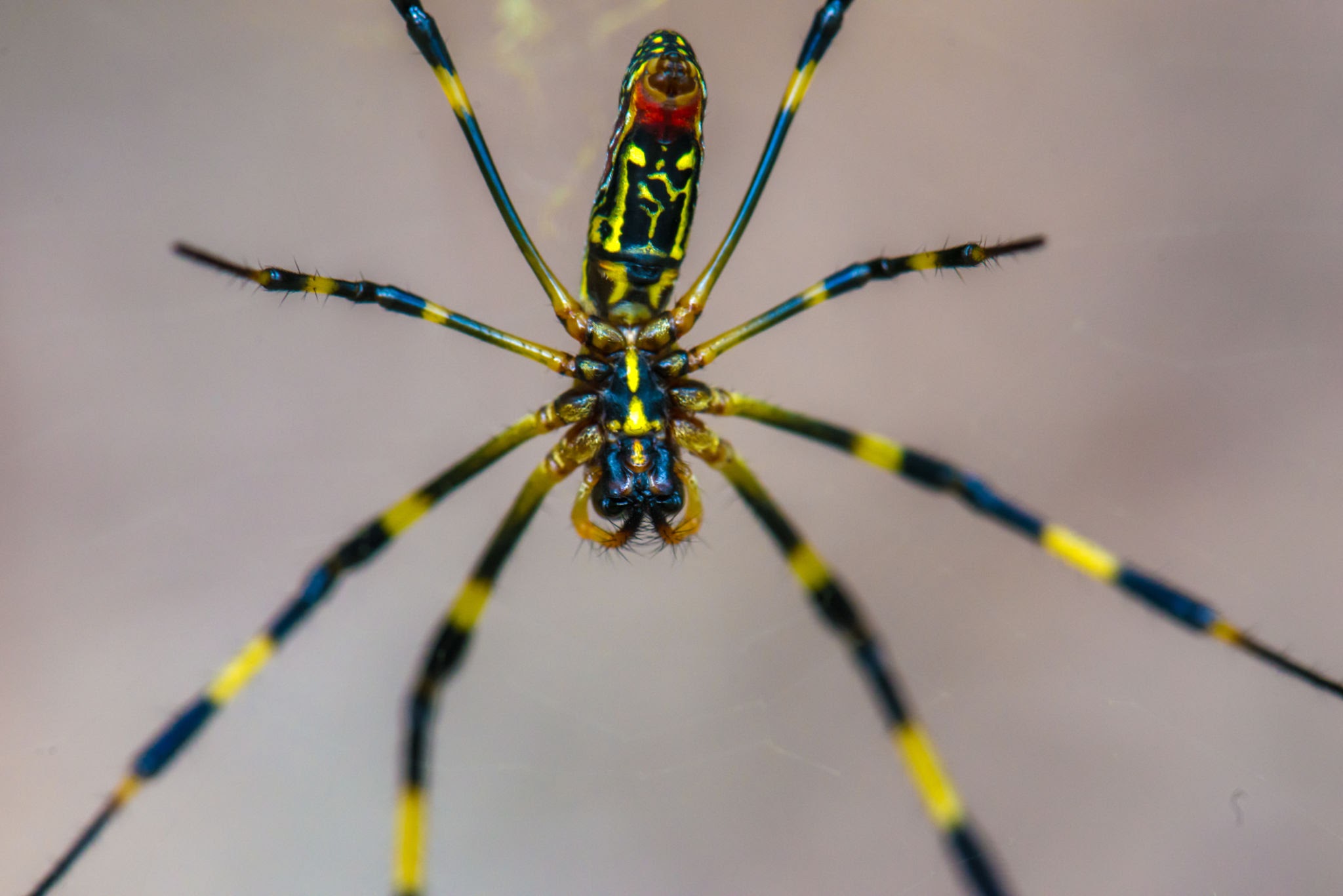Trichonephila clavata, also known as the Joro spider, Korea, Taiwan, China. Due to its large size and the bright, unique colors of the female Trichonephila, the spider is well-favored in Japan.
Scientific name: Nephila clavata
Class: Arachnida
Domain: Eukaryota
Family: Nephilidae
Genus: Trichonephila
Kingdom: Animalia
Order: Araneae

Is a Trichonephila Clavata poisonous?
Although the spider is not aggressive, they will bite to protect themselves. The bite is considered painful, but not life-threatening.
What does a Trichonephila clavata look like?
The key characteristics of a Trichonephila clavata are:
Extremely long legs (legs can be four times as long as the body)
Striped legs (often yellow and black)
Bright colors (red, yellow, brown, blue, black)
Usually appear in fall months (September and October)
Weave distinct three-layered, orb-shaped, gold-tinted webs
The adult female Trichonephila clavata is large and brilliantly colored with bright yellow and grey-blue bands and patterns on both its upper and lower abdomen. The cephalothorax is covered with silvery and golden hairs, and the legs are black with yellow bands.
Trichonephila clavata size
Maybe the most stunning feature of this spider is its size. Female body length can measure up to 1 inch, with a leg span of up to 4 inches. To put that into perspective, the average size of a human palm is 3.1 to 3.5 inches.
The adult female’s body size is 17–25 millimetres (0.67–0.98 in) while the male’s is 7–10 millimetres (0.28–0.39 in). The web of females may reach several meters in length.
Females lay eggs in the fall. There can be up to 1,500 eggs in a thick-walled sac that’s covered in bright yellow silk. Baby Trichonephila clavatas hatch in the spring and look like smaller versions of their adult counterparts.
Male Trichonephila clavatas are much smaller and not as vibrantly colored when compared to females. Their body length is typically 0.3 inches, with more dark brown colors.

Are Trichonephila clavatas poisonous?
Trichonephila clavatas are poisonous, but do not pose a danger to humans as they are typically reluctant to bite and their venom is very weak. The fangs of a Trichonephila clavata are essentially incapable of piercing or breaking human skin. Trichonephila clavatas will often only attempt to bite if they are being constrained. Science tells us that the Trichonephila clavata is not considered to be dangerous. In fact, these spiders are considered merely a nuisance to humans.
Are Trichonephila clavatas harmful to your pets? Again, Trichonephila clavata poison is extremely weak. If somehow the spider manages to puncture your pet’s skin (which is unlikely), the animal may have an allergic reaction. Ingesting a Trichonephila clavata could cause an upset stomach.
Trichonephila clavata origins and habitats
Named after a Japanese spider demon (Jorogumo), Trichonephila clavatas hail from Southeast Asia. They are common in China, Japan, Korea, Taiwan, and Vietnam. Back in the early 2010s, the spider somehow arrived in Georgia, likely via shipping containers imported into the US. Since then, these arachnids have been spotted in various points across the southeast.
While Trichonephila clavatas prefer warmth and humidity, they can survive in virtually any weather. Recent research indicates they may be able to survive in much colder temperatures than originally known. Their resistance to the cold could cause them to spread to the colder states in the future.
Trichonephila clavata lifespan
The Trichonephila clavata’s lifespan is typically around 12 months. An adult female spider lays its eggs in the fall. One egg sac can contain between 400 and 1,500 eggs. Baby Trichonephila clavatas hatch in the spring or early summer.
It takes around two to three months for spiderlings to reach sexual maturity. Before then, these pests are mostly unnoticeable to humans. Baby Trichonephila clavatas can transport themselves through ballooning. They release silk, stay attached to it, and let the wind carry them to their next destination. Ballooning allows Trichonephila clavatalings to travel up to hundreds of miles.
What do Trichonephila clavatas eat?
A Trichonephila clavata’s diet includes a variety of insects, such as mosquitos, stink bugs, yellow jackets and biting flies. They wait until a small insect gets tangled in their web. Once it’s inside, the spider wraps the prey in silk and uses venom to subdue it.
What eats the Trichonephila clavata?
Trichonephila clavatas are typically food for birds and other predators that eat spiders and insects. Since these spiders are fairly new to the US, their role and impact on the ecosystem remains unclear.
Trichonephila clavata web strength and applications
Trichonephila clavatas weave strong, three-layered webs that can be up to 10 feet wide. A research team at Shinshu University in Japan used genes of Trichonephila clavatas in silkworms in order to develop durable spider silk.
This new, high-tensile fiber can have many uses. For example, it’s great for making stockings and socks, as well as fishing line and tennis racket netting.
Are Trichonephila clavatas a threat to native ecology?
As with most invasive, non-native species, there is a lot we don’t yet know or understand about the Trichonephila clavata. Their impact on native species and environments is not clear right now, but many researchers believe their presence will not be threatening.
How are Trichonephila clavatas moving about the United States?
Trichonephila clavatas use two primary methods to move around. One method is by hitchhiking with humans – winding up in cargo shipped around the world and finding their way to new lands. The other method is through a process known as ballooning.
Ballooning is when newly hatched spiderlings climb as high as they can, stand on raised legs and then release several threads of silk from their spinnerets. These thin silk threads act as a parachute of sorts. As they’re being swept up in air currents, the spiderlings will travel with the wind.

Depending on species and other environmental factors (like wind speeds), ballooning may carry spiderlings from tens to hundreds of miles away. Current estimates only have the Trichonephila clavata being moved into bordering states no more than 80 miles away from where it was originally found. That’s roughly about 8-10 miles per year so far.
Is control of the Trichonephila clavata necessary?
Due to their lack of medical and economic impact, control measures haven’t been necessary or established for Trichonephila clavatas. The Trichonephila clavata is a nuisance pest and doesn’t present enough of a threat to require pesticide applications.
If Trichonephila clavatas and their webs are found on or around a structure, they can be removed with a broom or a cobweb removal brush.
Don’t panic about the Trichonephila clavata
This new Trichonephila clavata research suggests that the Trichonephila clavata can exist in colder climates outside of the southeastern United States, but does not imply they’ll soon be dropping from the sky in masses into backyards across the country. While there’s potential for the Trichonephila clavata to move to and survive in cooler climates, there’s no data to support that they will spread quickly.
Trichonephila clavata prevention tips
While Trichonephila clavatas aren’t dangerous to humans, they can be a serious nuisance. If you want to prevent these pests from settling in your yard or around the house, consider these prevention tips:
Watch your landscaping. Rich vegetation against your house could cause Trichonephila clavatas to settle there.
Don’t leave outdoor lights on. Bright lights can attract insects, which in turn can attract Trichonephila clavatas that will eat them.
Eliminate hiding places. Trichonephila clavatas prefer lush vegetation, leaf piles, and woodpiles.
Clean your home regularly to check for spider webs and remove them.
Seal cracks and holes around windows and doors to prevent spiders from entering.
If prevention methods don’t work, and you find Trichonephila clavatas in your yard, consider contacting a pest control specialist.
